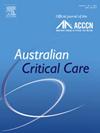预防性无创通气对断奶的影响:荟萃分析的系统回顾
IF 2.7
3区 医学
Q2 CRITICAL CARE MEDICINE
引用次数: 0
摘要
目的探讨预防性无创通气(NIV)对重症监护病房(ICU)患者再插管、拔管后呼吸衰竭、住院时间(LOS)和死亡率的影响。方法对数据库进行系统评价,并进行meta分析。我们纳入了在成人中进行的随机或准随机临床试验,机械通气时间为48小时,在自主呼吸试验中表现良好,并比较了预防性NIV与补氧的使用。结果本综述纳入了6项研究。在结果再插管中,赞成预防性NIV的差异(优势比[OR]: 0.49;95%可信区间[CI]: 0.32, 0.74), ICU死亡率(OR: 0.39;95% CI: 0.21, 0.71),医院死亡率(OR: 0.53;95% CI: 0.33, 0.85), ICU LOS(中位[MD]: -2.86;95% CI:−5.47,−0.24),拔管后呼吸衰竭发展(OR: 0.28;95% ci: 0.12, 0.67)。医院LOS差异无统计学意义(MD: - 0.42;95% ci: -3.42, 2.59)。在亚组分析中,主要在对照组使用抢救性NIV,结果无统计学差异。结论预防性NIV的使用降低了再插管率、ICU和医院LOS以及死亡率。这些发现支持在日常实践中使用它的建议。急救NIV可能降低了对照组接受手术的再插管率。普洛斯彼罗registrationCRD42022381099。本文章由计算机程序翻译,如有差异,请以英文原文为准。
Effects of prophylactic non-invasive ventilation on weaning: A systematic review with meta-analysis
Objective
The aim of this study was to evaluate the effects of prophylactic non-invasive ventilation (NIV) on reintubation, postextubation respiratory failure, length of stay (LOS), and mortality in the intensive care unit (ICU).
Method
A systematic review of the databases followed by meta-analysis was conducted. We included randomised or quasi-randomised clinical trials conducted in adults, with a mechanical ventilation time >48 h, who had good performance in the spontaneous breathing test and compared the use of prophylactic NIV with oxygen supplementation.
Results
Eleven studies were included in this review. There was a difference in favour of prophylactic NIV for the outcome reintubation (odds ratio [OR]: 0.49; 95% confidence interval [CI]: 0.32, 0.74), ICU mortality (OR: 0.39; 95% CI: 0.21, 0.71), hospital mortality (OR: 0.53; 95% CI: 0.33, 0.85), ICU LOS (median [MD]: -2.86; 95% CI: −5.47, −0.24), and postextubation respiratory failure development (OR: 0.28; 95 % CI: 0.12, 0.67). There was no difference noted for hospital LOS (MD: -0 0.42; 95% CI: -3.42, 2.59). In the subgroup analysis, the use of rescue NIV, mainly in the control group, showed no statistically significant difference in the outcomes.
Conclusion
The use of prophylactic NIV reduced reintubation rates, ICU and hospital LOS, and mortality. These findings support the recommendation for its use in daily practice. Rescue NIV may have reduced the reintubation rate in control group who underwent the procedure.
Prospero registration
CRD42022381099.
求助全文
通过发布文献求助,成功后即可免费获取论文全文。
去求助
来源期刊

Australian Critical Care
NURSING-NURSING
CiteScore
4.90
自引率
9.10%
发文量
148
审稿时长
>12 weeks
期刊介绍:
Australian Critical Care is the official journal of the Australian College of Critical Care Nurses (ACCCN). It is a bi-monthly peer-reviewed journal, providing clinically relevant research, reviews and articles of interest to the critical care community. Australian Critical Care publishes peer-reviewed scholarly papers that report research findings, research-based reviews, discussion papers and commentaries which are of interest to an international readership of critical care practitioners, educators, administrators and researchers. Interprofessional articles are welcomed.
 求助内容:
求助内容: 应助结果提醒方式:
应助结果提醒方式:


